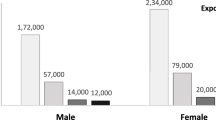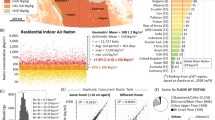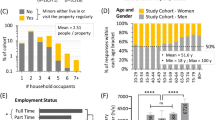Abstract
The Feed Materials Production Center (FMPC) at Fernald, Ohio produced uranium metal products for use in Department of Energy defense programs. Radium-contaminated waste material was stored on-site in two K-65 silos on the west side of the facility and provided a source of 222Ra. The initial objective of this study was to estimate radon exposures to employees at FMPC working from 1952 to 1988. A modified Gaussian plume model was used to estimate exposures to workers. In an effort to validate these model-based estimates, we used 138 CR-39 film assays from window glass sampled in buildings throughout the site. Results from the CR-39 assays indicated a second substantial source of radon, the smaller Q-11 silos located in the production area. A response-surface regression analysis using a cubic spline model was fit to the CR-39 data to estimate 210Po surface activity levels at geographic coordinates throughout the facility. Knowledge of the age of the glass, the amount of contaminated waste in the Q-11 silos, and 210Po decay rates were used to estimate annual exposures to radon decay products (WLM: working level months). Estimated WLM levels associated with the Q-11 source term indicated that employees working in the vicinity during the period when they were filled with radium-contaminated waste (1952–1958) received substantially higher radon exposures than those from the K-65 source during this period. Results of the two models, corresponding to the K-65 and Q-11 sources, were combined to estimate WLM levels by year for each of the 7143 Fernald workers during the period 1952–1988. Estimated cumulative exposures to individual workers ranged from <0.5 to 751 WLM. Estimated radon exposures from this newly discovered source have important implications for future epidemiologic studies of lung cancer in workers at the Fernald facility.
This is a preview of subscription content, access via your institution
Access options
Subscribe to this journal
Receive 6 print issues and online access
$259.00 per year
only $43.17 per issue
Buy this article
- Purchase on Springer Link
- Instant access to full article PDF
Prices may be subject to local taxes which are calculated during checkout


Similar content being viewed by others
Notes
A.P. Fews. Report to NIOSH on the surface concentration of Po-210 on window glass of a Uranium processing plant, May (2001).
1962 memo by J.J. Costa.
memo: “Removal Site Evaluation, Plant 1 Ore Silos,” August (1991).
P. Fews. Personal communication, February (2002).
References
BEIR I.V. Health Risks of Radon and Other Internally Deposited Alpha-Emitters. National Academy Press, Washington, DC, 1988.
Cardarelli J.J. Evaluation of Occupational Exposure to Radon at the Fernald Environmental Management Project. Master of Science Thesis, University of Cincinnati, 1992.
Cragle D.L., Watkins J.P., Ingle J.N., Robertson-Demers K., Tankersley W.G., and West C.M. Mortality Among a Cohort of White Male Workers at a Uranium Processing Plant: Fernald Feed Materials Production Center, 1951–1989. Center for Epidemiologic Research, Oak Ridge Institute for Science and Education, Oak Ridge, TN, USA, Final Report 1996.
Fews A.P., and Henshaw D.L. High resolution alpha particle spectroscopy using CR-39 plastic track detectors. Nucl Instrum Meth 1982: 197: 517–529.
Fews A.P. Fully automated image analysis of etched tracks in CR-39. Nuclear Instruments and Methods in Physics Research Section B: Interactions with Materials and Atoms 1992: 71 (4): 465–478.
Field R.W. A review of residential radon case–control epidemiologic studies performed in the United States. Rev Environ Health 2001: 16 (3): 151–167.
Killough G.G., Case M.J., Meyer K.R., Moore R.E., Rope S.K., Schmidt D.W., et al. The Fernald Dosimetry Reconstruction Project, Task 6—Radiation doses and risk to residence from FMPC Operations from 1951–1988, Radiologic Assessment Corporation (RAC) Report No. CDC-1. Volumes I and II (final report). Neeses, SC: September 1998.
Killough G.G., and Schmidt D.W. Uncertainty analysis of exposure to radon released from the former Feed Materials Production Center. J Environ Radioact 2000: 49: 127–156.
Lively R.S., and Steck D.J. Long-term radon concentrations estimated from 210Po embedded in glass. Health Phys 1993: 64: 485–490.
Lubin J.H., Boice J.D., Edling C., Hornung R.W., Howe G., Kunz E., et al. Radon and Lung Cancer Risk: A Joint Analysis of 11 Underground Miners Studies. National Institutes of Health, National Cancer Institute. NIH Publication no. 94-3644, Washington, DC, USA, 1994.
Mahaffey J.A., Parkhurst M.A., James A.C., Cross F.T., Alavanja M.C.R., Boice J.D., et al. Estimating past exposure to indoor radon from household glass. Health Phys 1993: 64 (4): 381–391.
Merrill E.A., and Akbar-Khanzadeh F. Diurnal and seasonal variations of radon levels, effects of climatic conditions, and radon exposure assessment in a former uranium metal production facility. Health Phys 1998: 74: 568–573.
Meyer K.R., Voilleque P.G., Schmidt D.W., Rope S.K., Killough G.G., Shleien B., et al. Overview of the Fernald Dosimetry Reconstruction Project and source term estimates for 1951–1988. Health Phys 1996: 71: 425–437.
Ritz B. Radiation exposure and cancer mortality in uranium processing workers. Epidemiology 1999: 10 (5): 531–538.
SAS Institute Inc.. SAS/STAT User's Guide Version 9. SAS Institute Inc., Cary, NC, USA, 2006.
Seixas N.S., Robins T.G., and Moulton L.H. The use of geometric and arithmetic mean exposures in occupational epidemiology. Am J Ind Med 1988: 14 (4): 465–477.
Steck D.J., Alavanja M.C., Field R.W., Parkhurst M.A., Bates D.J., and Mahaffey J.A. 210Po implanted in glass surfaces by long term exposure to indoor radon. Health Phys 2002: 83: 261–271.
Stone C.J., and Koo C.Y. Additive splines in statistics, In: Proceedings of the Statistical Computing Section American Statistical Association, Washington, DC, USA, 1985, 45–48.
Voilleque P.G., Meyer K.R., Schmidt D.W., Rope S.K., Killough G.G., Case M., et al. The Fernald Dosimetry Reconstruction Project, Tasks 2 and 3—radiologic source terms and uncertainties. Radiological Assessment Corporation (RAC) Report No. CDC-5, Neeses, SC 1995.
Acknowledgements
This research was supported in part by NIOSH Grant no. 1 RO1 CCR515748-01, and by the Fernald Workers Medical Monitoring Program.
Author information
Authors and Affiliations
Corresponding author
Appendix A
Appendix A
Radon transport model from K-65 silos to receptor locations
This appendix presents a brief summary of the models applied to the release and atmospheric transport of radon and progeny from the K-65 silos. The background for these models is extensive and complex, and space limitations preclude the inclusion of details here. The models are discussed more fully in the references. Please note that the SI units given in this appendix are intended to be a generic aid to the reader and may not necessarily be the units of corresponding quantities that were used in the simulations or presented in the results.
The Fernald Dosimetry Reconstruction Program, sponsored by the CDC, developed models of release history and atmospheric transport for radionuclides that were released from the former FMPC. Components of these models were calibrated to measurements that had been taken on the FMPC site and in the vicinity. Models specific to radon and its progeny were applied to releases from the K-65 silos and their atmospheric transport, and to the estimation of consequent air concentrations of these radionuclides at remote locations and dose (or WL) for exposed individuals at those locations (Killough et al., 1998).
The K-65 source term model is an empirical representation of the annual release of radon from the K-65 silos from 1952 through 1988. It was calibrated to a variety of data, primarily (1) the concentration of radon in the silo headspace gas, measured in 1987, (2) measurements of γ-ray exposure on the external silo dome surfaces before and after they were sealed, and (3) a series of temperature and pressure readings in the silo headspace gas, taken in 1987. It is a stochastic model, with some parameters derived as probability distributions, which propagate into the annual release estimates. Detailed information about the K-65 source term model and the ratio of decay products at the point of release is given in Appendix Q of Killough et al. (1998), with references to the earlier report of Voilleque et al. (1995) for some details.
Killough and Schmidt (2000) carried out an uncertainty analysis for off-site estimates of WLM, using a transport model for radon and its decay products that is based on its counterpart from the CDC dose reconstruction. Because of space limitations, however, they used a simplified surrogate for the K-65 source term, with statistical properties that approximated those of the more complicated authentic K-65 source term model. The transport model used for the study described in this paper is adapted from the transport model of Killough and Schmidt (2000), but it is coupled with the original K-65 source term developed for the CDC dose reconstruction study, as described in Appendix Q of Killough et al. (1998) and in Voilleque et al. (1995).
The atmospheric transport model for radon consists of a ground-level circular-source Gaussian plume (with horizontal and vertical dispersion parameters, σy and σz, associated with Pasquill-Gifford stability categories A–F):

The quantity D (m−2) is the centerline diffusion of the plume and depends only on the downwind distance x (m) from the center of the source area, the stability category (A–F) through the horizontal and vertical stability functions σy and σz (m), and the radius R (m) of the circular source area. The centerline ground-level concentration is χ (Bq/m3), u is the mean wind speed (m/s), Q is the release rate at the source (Bq/s), and f is the fraction of the time that the wind blows in the source-to-receptor direction. The function Pin the integrand is the standard normal cumulative distribution function.
The diffusion function of Eq. (A1) was multiplied by a two-parameter calibration factor CF=K (x/R)β (Figure A1), and the product was calibrated by regression to an aggregate of two sets of background-adjusted radon measurements taken on-site in the 1980s at various distances from the K-65 silos and at the site boundary (Figure A2). The K-65 source term model estimates for the years appropriate to the data were used in the calibration. Thus, uncertainty in the K-65 source term propagates into the distributions of the calibration parameters K and β. This calibration also involved complexities related to (1) differences in daytime and nighttime release rates from the silos and (2) unstable air associated with daytime and stable air associated with nighttime. The unstable air contributes to vertical mixing of the radon, resulting in lower ground-level radon concentrations, whereas the stable nighttime air leads to higher ground-level concentrations of radon near a ground-level source. However, the concentration data are not broken down into daytime and nighttime components but are represented as 24-h averages. These asymmetries were considered in the calibration. We refer the reader to Killough et al. (1998) and Killough and Schmidt (2000) for details.
The figure indicates the geometry of the calibration factor for fitting the atmospheric diffusion curve to background-adjusted atmospheric radon measurements taken on the FMPC site during the 1980s. When the equation y=K(x/R)β D(x, R, x≥R, is plotted with logarithmic axes, the parameters K and β control vertical displacement and shear rotations, respectively, of the graph of the diffusion function D(x,R)=χu/(Qf) (see text for meanings of symbols). A regression procedure uses the radon data and the K-65 source term model for years appropriate to the data to estimate the joint distribution of (K, β).
The figure indicates the radon air monitoring data, background-adjusted and converted to daytime diffusion estimates, and fitted by a regression procedure with the Gaussian circular area-source model y=K(x/R)β D(x, R). The regression curve (black line) and a corresponding uncalibrated model curve (dashed line) are also shown. This figure is an illustration, restricted to daytime parameter.
Meteorological data for the calibration and simulations were represented as an annual joint frequency table (wind speed, wind direction, and Pasquill-Gifford stability category). A composite table was derived from hourly measurements taken during the period 1987–1991 at an instrumented tower on the site (sampling was available for a few months of 1986, but none for previous years). Further discussion of this data set may be found on pages 51–54 of Appendix M of Killough et al. (1998). Applying this 5-year composite joint frequency table to specific years (particularly those before 1987) gives rise to uncertainty associated with year-to-year meteorological variability. This component of uncertainty was estimated by studying its counterpart in a long run (1951–1991) of meteorological data taken at the Cincinnati Airport. The approach is described in Killough et al. (1998), Appendix M, beginning on page M-54.
The atmospheric transport model uses the kinetics of the 222Rn decay chain and the source-to-receptor transit time to estimate concentrations of 218Po, 214Pb, and 214Bi in air at the downwind receptor location. The resultant concentrations are combined to calculate the WL estimate

where the quantities in square brackets are expressed in Bq/m3 of air (converted from the pCi/m version given by NCRP 1984, Eq. (7-1), p. 84). We note that the in corresponding equation (Eq. (6)) of Killough and Schmidt (2000), the coefficients shown are incorrect, but the calculations reported there were performed with the correct equation.
Rights and permissions
About this article
Cite this article
Hornung, R., Pinney, S., Lodwick, J. et al. Estimation of radon exposures to workers at the Fernald Feed Materials Production Center 1952–1988. J Expo Sci Environ Epidemiol 18, 512–523 (2008). https://doi.org/10.1038/sj.jes.7500645
Received:
Accepted:
Published:
Issue Date:
DOI: https://doi.org/10.1038/sj.jes.7500645
Keywords
This article is cited by
-
Variations of radon and airborne particulate matter near three large phosphogypsum stacks in Florida
Environmental Monitoring and Assessment (2021)
-
Exposure assessment for a cohort of workers at a former uranium processing facility
Journal of Exposure Science & Environmental Epidemiology (2012)





